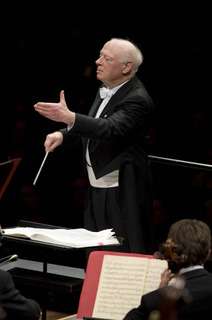|
Back
An Old Master Lucerne
KKL
03/27/2010 - & March 11, 12 (München)
Anton Bruckner: Symphony No. 5, WAB 105
Symphonieorchester des Bayerischen Rundfunks, Bernard Haitink (conductor)

B. Haitink (© Priska Ketterer)
Hearing and watching Bernard Haitink conduct a Bruckner symphony must now be like having been able to watch Rembrandt paint a portrait to be hung in the Rijksmuseum. Here is a conductor who has had Bruckner in his veins for decades. He first heard a Bruckner symphony (No. 8, Concertgebouw under Eduard van Beinum) on the radio when he was 10 and was bowled over by it, although at that age he did not know why. Later he heard Eugen Jochum conduct Bruckner in the Concertgebouw; Haitink lived nearby. He says he was frightened by Mahler, whose music had been banned in the years of Nazi occupation whereas Bruckner’s was considered “clean Aryan” music.
Haitink, of course, performed the “original” version. Bruckner actually never heard the work performed in its original version, only a piano version for two pianos. He was too ill, in 1894, to travel to Graz to hear the work performed under Franz Schalk (Bruckner died two years later). That probably saved him some aggravation, as he would probably not have recognised the work, shortened and re-orchestrated by Schalk. Although Haitink almost always prefers the score in front of him, it is evident that the notes and the structure are second nature to him. No exaggerated gestures, no jumps, the left hand raised with clenched fist to denote “a little more power please”, otherwise the baton steady like a metronome beat, and above all no pulling about with the tempi. Some might miss a certain springiness as with the late Günter Wand’s performances, Haitink delivers solidity, feet firmly on the stage. His performances in the 70s and 80s were faster, as he puts more “sportif”; now he prefers a more mature and measured approach.
The work itself is not always approachable and not performed as often as the later symphonies. The opening movement is bitty and even appears crude in part; it takes quite a while for the movement to build dramatically. Haitink’s skill however was to maintain the audience’s concentration throughout and display’s the work’s structure. The introvert Adagio opened with a fine solo from the principal oboe, orchestral volume was kept restrained to accentuate the outbursts of sound which then came over as spectacular. The strings were mellow and warm in their long lyrical passages. There was a proper spring in the step during the outer parts of the Scherzo and the Bavarians displayed a deft charm in the central Ländler section; the Austrian border is within sight of Munich on a clear day. The final movement is the most satisfactory and the most approachable. Haitink kept exact control of the complex contrapuntal sections, rhythm never slackened and the final pages thrilled, just as they should, with their blazing brass chorales.
The orchestra, Munich’s principal orchestra, is of course a precision instrument and no stranger to Bruckner. Jochum was chief conductor for 11 years (although that was way back in 1949); he was followed by a veritable roll-call of prestigious conductors, Kubelík, Colin Davis, Maazel and now Jansons. They showed prowess in all areas and were clearly on top form.
The painting had been completed.
John Rhodes
|